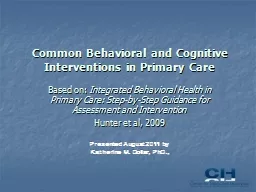

Based on Integrated Behavioral Health in Primary Care StepbyStep Guidance for Assessment and Intervention Hunter et al 2009 Presented August 2011 by Katherine M Dollar PhD Whats in Your Toolbox ID: 805716
Download The PPT/PDF document "Common Behavioral and Cognitive Interven..." is the property of its rightful owner. Permission is granted to download and print the materials on this web site for personal, non-commercial use only, and to display it on your personal computer provided you do not modify the materials and that you retain all copyright notices contained in the materials. By downloading content from our website, you accept the terms of this agreement.
Slide1
Common Behavioral and Cognitive Interventions in Primary Care
Based on:
Integrated Behavioral Health in Primary Care: Step-by-Step Guidance for Assessment and Intervention
Hunter et al, 2009
Presented August 2011 by
Katherine M. Dollar, PhD.,
Slide2What’s in Your Toolbox?
2
Slide3The Co-located, Collaborative Provider’s Toolkit The following 8 techniques are effective for addressing a wide variety of symptoms and functional impairment seen in primary care (Hunter et al., 2009)
1. Relaxation training
2. Goal setting
3. Identifying and disputing negative cognitions
4. Motivational Interviewing
5. Problem Solving
6. Self-monitoring7. Behavioral Activation8. Assertive Communication
3
Slide4Relaxation TrainingDeep Breathing
Cue-controlled relaxation
Progressive muscle relaxation
Visual imagery
4
Slide5Goal SettingAre the goals well defined in behavioral terms? (S.M.A.R.T)
Realistic/achievable
With in realm of control/influence
Break into sub goals
Personally important
Whose goals are they anyway?
5
Slide6Identifying and Disputing Negative Cognitions Help to indentify unhealthy cognitions (predictions, expectations, evaluations)
Use thought logs
Question thought process
“Cognitive Disputation”
Self-help books for highly motivated
Mind Over Mood:
Greenberger and Padesky6
Slide7Motivational Interviewing Examine readiness to change (Readiness Ruler)
Examine importance and confidence for change
Elicit pros and cons of change
7
Slide8Problem Solving
A five-step problem-solving model is recommended for the PC setting
(
Nezu
, personal communication, 2011)
Minimize emotional arousal to focus on next 4 stepsSet an achievable goal, identify major obstaclesBrainstorm multiple alternatives to overcoming obstacles
Identify pros and cons of each idea, cost-benefit analysisImplement
an
action plan
and assess the outcome (either fine-tune or go back through steps 1-4)
Please note: Additional PST trainings will be available in the future.
8
Slide9Self-Monitoring Help track progress towards a goal
Use a calendar
Keep a tally
Chart on a graph
9
Slide10Behavioral Activation
Difficult to feel depressed when engaged in actives that provide pleasure and accomplishment
Re-establish routines
Increase reinforcing experiences
Overcome avoidance patterns
Distraction from problems or unpleasant events
10
Slide11Behavioral Activation TechniquesChoose and schedule daily pleasurable activities
(Pleasant Events Schedule or Life Activities Checklist)
List activities and rate for mastery and pleasure
Keep activity logs
11
Slide12Assertive CommunicationAssess patterns of communication
Explain differences in passive, assertive, and aggressive communication
Help patient to learn how to speak assertively (Honest, Appropriate, Respectful, Direct)
Practice through role-play
The Anxiety and Phobia Workbook
12
Slide13Helpful Resources
Hunter, C. L., Goodie, J. L., Oordt, M. S., & Dobmeyer, A. C. (2009).
Integrated Behavioral Health in Primary Care: Step-by-step Guidance for Assessment and Intervention
, American Psychological Association.
Gatchel, R. J. & Oordt, M. S. (2003).
Clinical health psychology and primary care: Practical advice and clinical guidance for successful collaboration
: Washington, DC; American Psychological Association.P. Robinson & J. Reiter (2007) Behavioral consultation and primary care: A guide to integrating services. New York: Springer Science-Media.
W. O'Donohoe, M. Byrd, N. Cummings, D. Henderson (2005). Behavioral integrative care: Treatments that work in the primary care setting. New York: Brunner-Routledge.
13
Slide14Questions?
14
Slide15Helpful IPC Resources
http://vaww.visn2.med.va.gov/bh/cih/index.html
http://vaww4.va.gov/pcmhi/
http://
www.cfha.net
E-mail address:
katherine.dollar@va.gov
15